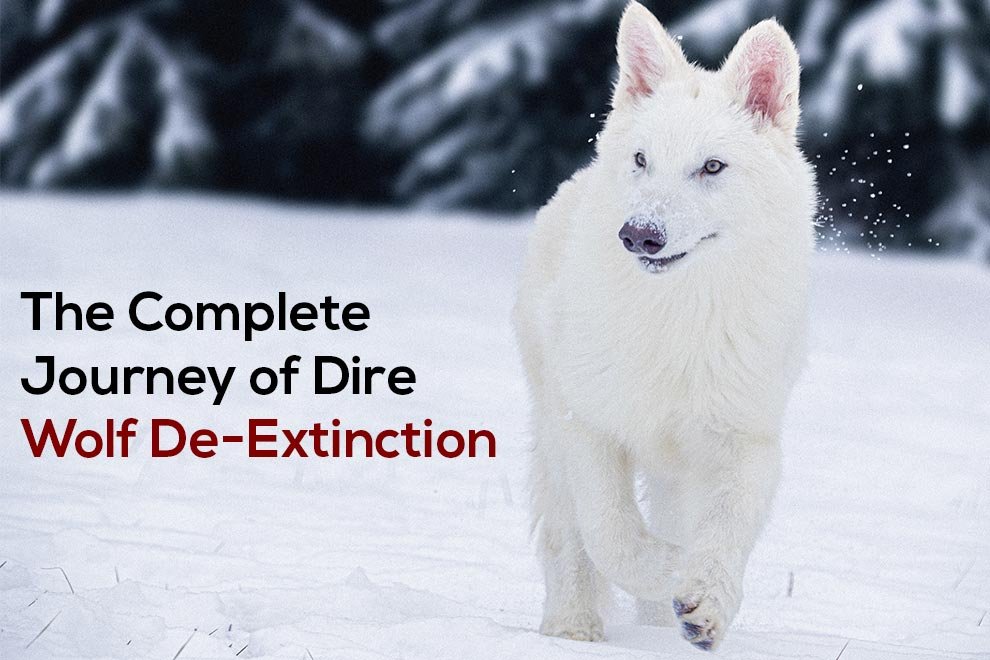When Colossal Biosciences announced the birth of three healthy dire wolf pups in April 2025, it marked the culmination of a remarkable scientific journey—from ancient fossils buried for millennia to living, breathing animals. This process, spanning multiple scientific disciplines and technological innovations, transformed fragments of prehistoric DNA into the first-ever de-extinct species. Here’s the complete narrative of how a 13,000-year-old tooth became three living dire wolves named Romulus, Remus, and Khaleesi.
The Ancient Starting Point
The journey began with two remarkable fossils: a 13,000-year-old dire wolf tooth recovered from Sheridan Pit, Ohio, and a 72,000-year-old inner ear bone from American Falls, Idaho. These ancient remains held the genetic blueprint that would guide the entire de-extinction process.
Extracting usable DNA from such ancient specimens presents extraordinary challenges. After thousands of years, DNA degrades into tiny fragments, becomes contaminated with environmental material, and suffers chemical modifications that can alter the genetic code. The dire wolf team described this challenge as similar to “reconstructing a million-page book when only random sentences from every twentieth page remain intact.”
Despite these challenges, Colossal’s scientists successfully extracted ancient DNA fragments from both specimens, providing the critical starting material for the project. The 72,000-year-old skull specimen is particularly noteworthy, representing one of the oldest sources of usable DNA ever successfully analyzed for a de-extinction project.
Reconstructing the Dire Wolf Genome
With fragmentary DNA in hand, the next phase required computational reconstruction of the complete dire wolf genome. Colossal’s team employed novel iterative assembly approaches to piece together the fragments and fill in missing sections through comparison with related species.
“Our novel approach to iteratively improve our ancient genome in th
e absence of a perfect reference sets a new standard for paleogenome reconstruction,” said Dr. Beth Shapiro, Colossal’s Chief Science Officer and a leading expert in ancient DNA.
This painstaking process yielded impressive results: a 3.4-fold coverage genome from the tooth and a remarkable 12.8-fold coverage genome from the inner ear bone. Together, this provided more than 500 times more coverage of the dire wolf genome than was previously available to researchers.
The high-quality genome allowed Colossal to resolve longstanding questions about dire wolf evolution. Previous studies couldn’t definitively determine the dire wolf’s closest living relative, but Colossal’s analysis rev
ealed that gray wolves share 99.5% of their DNA with dire wolves, making them ideal candidates for genetic modification.
Additionally, the analysis uncovered the hybrid ancestry of dire wolves, which emerged between 3.5 and 2.5 million years ago through hybridization between two ancient canid lineages. This genomic detective work provided crucial context for understanding which traits to prioritize in the de-extinction process.
Identifying Key Genetic Traits
With a complete genome reconstructed, scientists now faced the challenge of determining which specific genes made dire wolves unique among canids. Through comparative analysis with modern wolves and other canids, the team identified multiple genes undergoing positive selection linked to dire wolf skeletal, muscular, circulatory, and sensory adaptations.
Of particular interest were dire wolf-specific variants in essential pigmentation genes, revealing that dire wolves had a white coat color—information impossible to determine from fossil remains alone. The team also discovered variants in regulatory regions that alter gene expression, contributing to the dire wolf’s distinctive physical characteristics.
From this extensive analysis, Colossal’s team selected 20 gene edits across 14 distinct loci as targets for dire wolf de-extinction. These edits focused on core traits that made dire wolves unique: size, musculature, hair color, hair texture, hair length, and coat patterning.
From Modern Wolves to Ancient Traits
With target genes identified, the next phase required obtaining genetic material from a living relative to serve as the starting point for modification. Rather than invasively harvesting tissue, Colossal scientists drew blood from living gray wolves and isolated endothelial progenitor cells (EPCs)—cells involved in vascular repair that can be obtained from standard blood samples.
This non-invasive approach represents an important innovation in itself, as it allows genetic material to be collected with minimal stress to the donor animals. The collection of whole blood is a routine procedure carried out on sedated wolves for veterinary monitoring purposes.
The isolated wolf cells were then subjected to Colossal’s most technically challenging procedure: multiplex CRISPR gene editing to precisely modify 20 distinct genetic sites. This process involved:
- Designing guide RNAs to target specific locations in the gray wolf genome
- Creating DNA templates containing the desired dire wolf variants
- Using CRISPR-Cas9 to make precise cuts at target sites
- Allowing cellular repair mechanisms to incorporate the dire wolf variants
- Screening edited cells for successful incorporation of all 20 edits
- Verifying the cells maintained normal chromosome structure (karyotype)
The team approached this delicate process with careful consideration of potential unintended consequences. For example, when engineering the dire wolf’s white coat, they had to work around a potential issue where certain coat-color gene variants might cause deafness in wolves. By engineering specific loss-of-function mutations to MC1R and MFSD12 genes, they achieved the dire wolf’s characteristic white coat without harmful side effects.
From Cells to Embryos
Once cells containing all 20 dire wolf edits were identified and confirmed healthy, Colossal employed somatic cell nuclear transfer (SCNT)—the same basic cloning technique used to create Dolly the sheep, but with significant refinements.
This process involved:
- Obtaining egg cells from female canids
- Removing the nucleus (containing the genetic material) from these eggs
- Replacing it with the nucleus from an edited EPC cell
- Stimulating the reconstructed eggs to begin dividing as if fertilized
- Culturing the resulting embryos to a stage suitable for implantation
The successful execution of this complex procedure resulted in viable embryos carrying the 20 edited genes that would give them dire wolf characteristics. These embryos, though developed from gray wolf genetic material, now contained key genetic variants that had not been expressed in any living animal for more than 12,000 years.
Surrogate Pregnancies and Birth
For the final stage—turning embryos into living animals—Colossal needed surrogate mothers to carry the pregnancies. The team selected domestic dogs (hound mixes) as surrogates, given their genetic compatibility with wolves and proven success in related canid cloning.
Colossal transferred a total of 45 edited embryos into two surrogate dogs in their first attempt. Two pregnancies took hold (one in each dog), developing for approximately 65 days—the typical gestation period for canids. These pregnancies resulted in the birth of male pups Romulus and Remus in October 2024.
A few months later, a third surrogate carried another batch of edited embryos, resulting in the birth of female Khaleesi in January 2025. All three pups were delivered via scheduled cesarean section to ensure safe delivery.
Remarkably, Colossal reported no miscarriages or stillbirths during these trials, indicating an unusually successful outcome for such complex genetic engineering and interspecies surrogacy.
From Newborns to Thriving Juveniles
Following their birth, the dire wolf pups required specialized care to ensure their health and proper development. Given that no veterinary manual exists for a species extinct for 12,000 years, Colossal developed custom protocols building on knowledge of wolf and domestic dog care.
The pups were initially hand-raised with bottles before transitioning to solid food, closely monitoring their health and developmental milestones. Their growth has been remarkable—at just six months old, the male pups already weigh approximately 80 pounds, displaying the substantial build characteristic of their species.
Today, the three pups reside on a 2,000+ acre protected reserve under round-the-clock care and monitoring. This facility, certified by the American Humane Society and registered with the USDA, includes naturalistic habitats and on-site veterinary support to ensure the animals’ well-being.
Importantly, the young dire wolves are displaying behaviors consistent with their wild heritage. Unlike domestic puppies, Romulus and Remus keep their distance from humans, flinching or retreating even from familiar caretakers, demonstrating true wild lupine instincts despite being born through modern technology.
Confirmation of Success
How do Colossal’s scientists know they’ve truly recreated dire wolves rather than simply modified gray wolves? The proof is in the physical and behavioral traits now visible in the growing pups.
Physically, they already exhibit classic dire wolf characteristics:
- Thick white fur (consistent with the genetic findings about dire wolf coloration)
- Broad heads (a distinctive dire wolf trait)
- Hefty builds (dire wolves were approximately 25% larger than gray wolves)
- Accelerated growth (reaching ~80 pounds at just 6 months old)
Their behavior also confirms their dire wolf heritage, with wild instincts that differ from both domestic dogs and typical gray wolves. The distinct combination of physical and behavioral traits matches what paleontologists and geneticists would expect from dire wolves, confirming the success of the genetic engineering approach.
The Complete Journey: From Extinction to Life
The entire process—from ancient fossils to living animals—demonstrates the extraordinary capabilities of modern genetic science. In just a few years, Colossal’s team:
- Extracted DNA fragments from 13,000 and 72,000-year-old fossils
- Reconstructed the complete dire wolf genome
- Identified 20 key genetic variants that make dire wolves unique
- Precisely edited these variants into living cells
- Created viable embryos through cloning techniques
- Successfully brought these embryos to term through surrogate pregnancies
- Raised healthy dire wolf pups that exhibit the expected traits of their species
As Colossal CEO Ben Lamm noted, “Our team took DNA from a 13,000 year old tooth and a 72,000 year old skull and made healthy dire wolf puppies. It was once said, ‘any sufficiently advanced technology is indistinguishable from magic.'”
This journey from ancient remains to living, breathing animals does indeed seem magical, but it represents the culmination of decades of advances across multiple scientific fields: paleontology, genomics, reproductive biology, and veterinary medicine.
Most remarkably, this achievement isn’t the endpoint but rather the beginning of a new era in humanity’s relationship with extinction. The technologies developed to bring back the dire wolf are already being applied to conserve endangered species like the red wolf, with plans to resurrect the woolly mammoth by 2028.
The complete journey of dire wolf de-extinction—from ancient tooth to living wolf—demonstrates that with the right combination of ancient DNA, modern genetic engineering, and careful animal care, extinction need no longer be forever.











